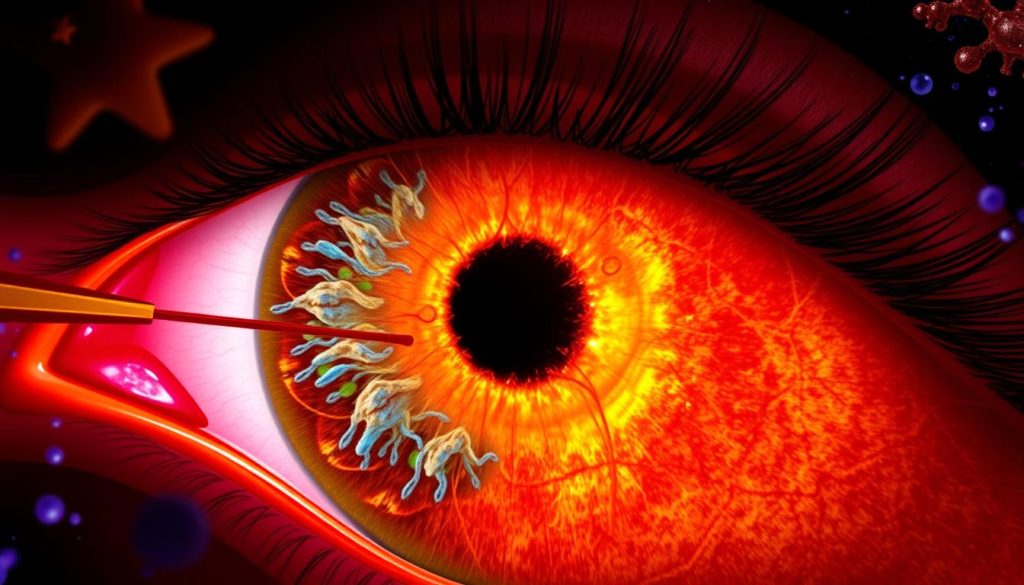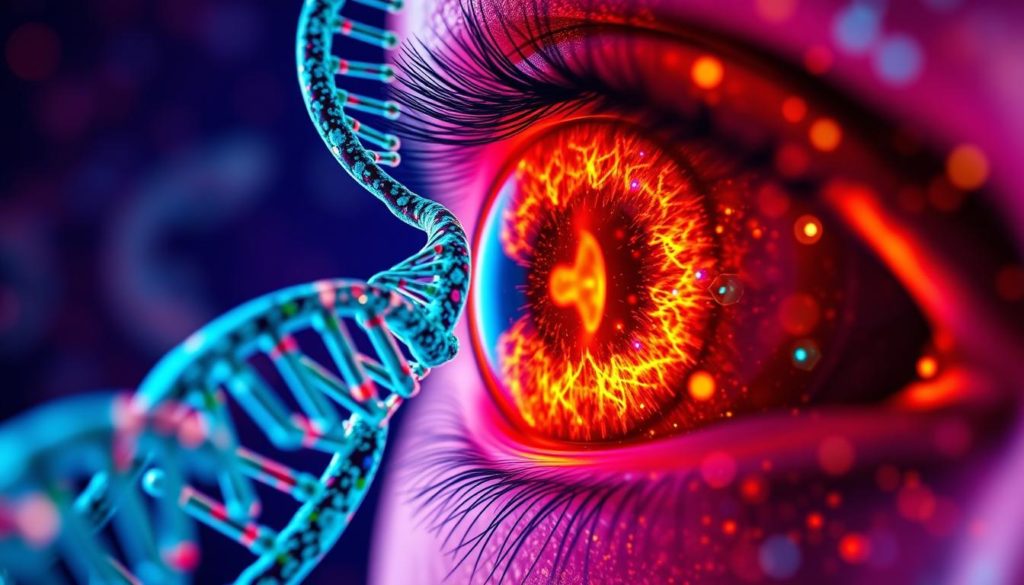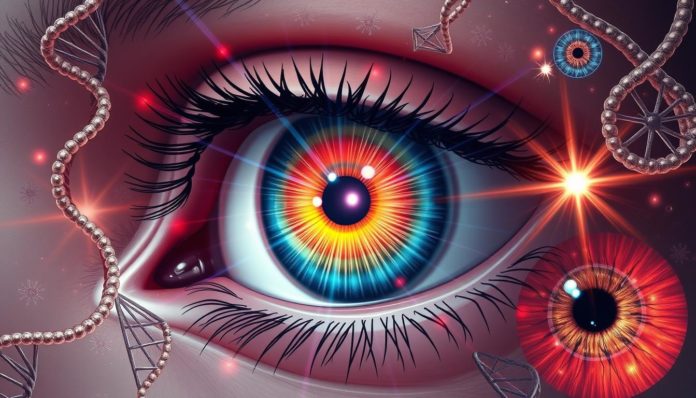“The greatest weapon against stress is our ability to choose one thought over another.” — William James
Macular Retinal Dystrophy (MRD) is a genetic eye disease. It slowly takes away the sharp vision we need for daily tasks like reading and seeing faces. Knowing about MRD is key for those affected and their families. It helps them understand and deal with the loss of vision.
The National Eye Institute says taking care of the macula is the first step in fighting retinal dystrophies. The American Academy of Ophthalmology points out that these diseases are a big problem worldwide.
What is Macular Retinal Dystrophy?
Macular Retinal Dystrophy (MRD) is a rare genetic eye disorder. It causes the macula to degenerate, leading to vision loss. Unlike age-related macular degeneration, MRD is inherited and can start at any age.

Definition and Overview
The World Health Organization defines macular disorders, including MRD. MRD affects the macula, the part of the retina that helps us see details. This damage causes blurred vision and makes it hard to recognize faces, impacting daily life.
Retinal International says hereditary macular disorders have a clear pattern of inheritance. This means families need detailed genetic counseling. Knowing the difference between MRD and other retinal dystrophies helps doctors find the right treatment.
Importance of Early Diagnosis
Spotting macular degeneration early is key to managing it. Studies show that catching symptoms early can slow down the disease. Early detection allows for treatments that can save vision and improve life quality.
| Characteristic | MRD | AMD |
|---|---|---|
| Age of Onset | Any Age | Typically 50+ |
| Genetic Basis | Hereditary | Mostly Non-Hereditary |
| Symptoms | Blurred Vision, Difficulty Recognizing Faces | Central Vision Loss, Distortion |
Causes of Macular Retinal Dystrophy
Macular Retinal Dystrophy (MRD) comes from a mix of genetic and environmental factors. Knowing these causes helps in managing Inherited Retinal Conditions better. It also helps in reducing their effects.

Genetic Factors
Genetics are key in MRD. The Genome Research Institute found certain genes linked to this condition. These genes are often passed down in families, causing Inherited Retinal Conditions.
Some important genes include:
- Mutations in the ABCA4 gene
- Differences in the ELOVL4 gene
- Variations in the PROM1 gene
These genes can mess up vision, causing the macula to degenerate over time.
Environmental Influences
Genetics aren’t the only thing. Environmental factors also affect MRD. Studies from Environmental Health Perspectives show that some environmental factors can make MRD worse. These include:
- Smoking
- Prolonged exposure to ultraviolet (UV) light
- High-fat diets
These factors can work with genetics to harm retinal health more. Knowing this, people at risk might slow MRD’s progress by changing their lifestyle.
Symptoms of Macular Retinal Dystrophy
Knowing the symptoms of MRD is key for early detection and care. This condition can affect daily life in many ways.
Early Signs
Early signs of macular dystrophy include subtle vision changes. You might find it hard to read small text or recognize faces. Blurriness and distorted vision are also signs.
These symptoms can be mistaken for eye strain or aging. But they might signal the start of MRD.
Don’t ignore minor signs. Sudden vision problems or trouble with tasks you used to do easily could be MRD. Getting medical help early can help manage the condition better.
Advanced Symptoms
As MRD gets worse, symptoms get more obvious. Advanced symptoms include losing central vision, making it hard to see things right in front of you. This can affect daily tasks like driving and reading.
Peripheral vision usually stays, but losing central vision is tough. People with MRD can progress at different rates. Some get worse fast, while others progress slowly.
Regular check-ups with a doctor are vital for managing MRD. The American Macular Degeneration Foundation and NORD patient stories show how MRD can impact life. Specialists stress the need to understand these symptoms for proper treatment and support.
Diagnosis of Macular Retinal Dystrophy
Diagnosing MRD needs a detailed approach. People go through several tests to understand their retinal health. A retinal examination is a key method. It lets optometrists check the macula for any issues.
Advanced imaging, like Optical Coherence Tomography (OCT), has changed how we diagnose MRD. The American Optometric Association says OCT scans give detailed images. This helps spot retinal diseases early and accurately.
Genetic testing for MRD is also vital. Since MRD can run in families, finding genetic mutations helps diagnose it. It also tells family members about their risk. Genetic counseling offers support and guidance.
Differentiating MRD from other conditions is important. For example, age-related macular degeneration looks similar to MRD. So, it’s crucial to tell them apart for the right treatment.
| Diagnostic Technique | Purpose | Source |
|---|---|---|
| Retinal Examination | Identify macular abnormalities | American Optometric Association |
| Optical Coherence Tomography (OCT) | High-resolution imaging of retinal structures | Ophthalmic Research |
| Genetic Testing for MRD | Identify genetic mutations linked to MRD | Genetic Counseling Resources |
Progression of Macular Retinal Dystrophy
The progression of MRD leads to a slow loss of vision, affecting daily life. Early detection of MRD can help slow down vision loss.
Stages of Disease
Macular Dystrophy’s stages differ for each person. They are mainly divided into three:
- Early Stage: At this point, vision loss is slight. Reading and central vision clarity may be hard. Regular eye exams are key for catching it early.
- Intermediate Stage: Vision problems become more obvious. You might see wavy lines or blank spots in the center. It’s time to look into treatments to manage symptoms.
- Advanced Stage: Vision loss is severe. Recognizing faces and doing daily tasks become hard. At this stage, comprehensive care and support are crucial for quality of life.
Rate of Progression
The speed at which Macular Retinal Dystrophy progresses varies. Genetic factors and early detection are important. Studies show the average progression rate is as follows:
| Stage | Approximate Duration | Symptoms |
|---|---|---|
| Early Stage | 1-5 years | Mild vision disturbances, detectable through routine eye exams. |
| Intermediate Stage | 5-10 years | Moderate vision loss, difficulty with detailed tasks such as reading. |
| Advanced Stage | 10+ years | Severe vision loss, significant impact on daily life and independence. |
Knowing the stages of macular dystrophy and how they affect vision loss helps. This knowledge allows optometrists and patients to create better treatment plans for MRD.
Treatment Options for Macular Retinal Dystrophy
Macular Retinal Dystrophy (MRD) is a tough condition, but there are treatments that offer hope. These include medicines, new therapies, and procedures. They aim to manage MRD symptoms and slow its progress.
Medications
Medications for Macular Dystrophy aim to ease symptoms and slow the disease. The FDA has approved drugs like aflibercept (Eylea) and ranibizumab (Lucentis). They help by stopping abnormal blood vessel growth in MRD. These drugs can help keep vision and reduce symptoms.
Therapies
New therapies are being explored for MRD. Gene therapy is one, aiming to fix or replace faulty genes. Recent studies with CRISPR technology show great promise. They could be a big step forward in treating MRD.
Procedures
There are also surgical and non-surgical procedures for MRD. Vitrectomy, for example, removes the vitreous gel to improve vision. Photodynamic therapy and retinal implants are other options. They aim to keep or improve vision. The American Society of Retina Specialists says these treatments can greatly improve patients’ lives.
Here’s a quick look at the different treatments:
| Treatment Type | Description | Key Benefits |
|---|---|---|
| Medications | Drugs like aflibercept and ranibizumab | Reduces symptoms and halts progression |
| Gene Therapy | CRISPR and other genetic repair techniques | Targets root genetic causes |
| Procedures | Vitrectomy, photodynamic therapy, retinal implants | Improves or preserves vision |
Living with Macular Retinal Dystrophy
Living with Macular Retinal Dystrophy (MRD) means finding ways to stay independent and improve your Quality of Life. It’s important to use Vision Support Services to help with everyday tasks.
There are many resources and technologies available. The Foundation Fighting Blindness offers support and advice. Assistive technologies can also make daily life easier, as seen in top industry reviews.
- Screen readers and magnifiers
- Text-to-speech software
- Specialized lighting and large-print materials
Using these tools can really help improve your life. It’s also key to get emotional and psychological support. Therapy or joining support groups can help a lot.
“Support groups offer a space to share experiences and strategies,” a psychologist specializing in chronic conditions notes, “which is vital for emotional well-being.”
| Type of Support | Example | Benefits |
|---|---|---|
| Assistive Technology | Screen Readers | Improves Accessibility |
| Vision Support Services | Support Groups | Emotional and Social Support |
| Daily Living Aids | Large-Print Materials | Enhanced Readability |
Combining practical tools with emotional support can greatly help. Using all the resources available can lead to a fulfilling life despite MRD.
Impact on Daily Life
Living with macular retinal dystrophy brings many daily challenges. Simple tasks like reading, driving, and exploring new places become hard. To stay independent with visual impairment, learning adaptive techniques is key.
Occupational therapy helps a lot. It teaches ways to do daily tasks with less vision. They might suggest using magnifying glasses, brighter lights, or materials that stand out more.
Guide Dogs for the Blind and other groups offer tips for moving around safely. They help with traveling and getting around.
Learning adaptive techniques can make life easier. For example, using markers on appliances or voice commands can help a lot. These steps help you feel more in control and confident.
Health experts also talk about making lifestyle changes. Keeping your home tidy and following routines is important. These steps help avoid daily challenges and make life safer and more efficient.
The table below shows some useful adaptive techniques for daily life:
| Aspect of Daily Life | Adaptive Techniques |
|---|---|
| Reading | Magnifying tools, audio books |
| Driving | Public transportation, ride-sharing services |
| Navigation | Guide dogs, mobility training |
| Household Tasks | Tactile markers, voice-activated devices |
Prevention and Risk Management
Understanding and managing risk factors is key to Preventing MRD. By doing so, we can keep our vision healthy and our eyes in top shape.
Reducing Risk Factors
It’s important to know and lower risk factors for Preventing MRD. Getting regular eye checks is a must, as the World Health Organization suggests. If you have a family history of macular retinal dystrophy, genetic counseling can help you understand your risk.
Lifestyle Adjustments
Making healthy choices is crucial for Risk Management for Macular Dystrophy. The American Academy of Ophthalmology recommends eating foods full of vitamins and minerals. This includes vitamins C and E, and omega-3 fatty acids.
Also, quitting smoking, wearing UV protection, and controlling diabetes can help. These habits can greatly reduce the risk of macular retinal dystrophy.
By making these changes part of our daily lives, we can protect our eyes for the long term. This reduces the chance of getting symptoms related to macular retinal dystrophy.
Macular Retinal Dystrophy in Children
Macular Retinal Dystrophy (MRD) affects children differently than adults. Pediatric MRD shows varied symptoms that need special attention during diagnosis. Knowing about Inherited Macular Conditions in Children helps with early treatment and care.
Children with MRD face challenges in their vision development. This affects their learning and daily life. Since their vision is still growing, MRD can greatly impact their schoolwork and social skills. Studies in pediatric optometry stress the need for custom diagnostic methods to lessen these effects.
Supporting children with MRD requires a detailed plan. This plan should include educational adjustments and special services. Teachers and parents must work with experts to create personalized learning plans. These plans should meet the unique needs of children with Inherited Macular Conditions in Children.
| Support System | Details |
|---|---|
| Special Education Resources | Tools and techniques to help children with visual impairments thrive in school. |
| Vision Therapy | Exercises and activities designed to strengthen vision and manage symptoms. |
| Clinical Recommendations | Guidelines provided by healthcare professionals for optimal vision development and daily functioning. |
The aim is to use these resources and strategies to support children with Pediatric MRD. This creates an environment that helps with vision development while addressing the challenges of MRD. It’s crucial for healthcare providers, educators, and families to work together. This ensures the best quality of life and educational success for these children.
Advances in Research
The field of MRD Research has made big strides lately. Scientists and doctors are working together on new studies. This brings hope for better treatments and understanding of Macular Retinal Dystrophy (MRD).
Current Studies
Current Clinical Trials are key to moving MRD Research forward. The National Institutes of Health database lists many ongoing trials. These trials aim to find new treatments and understand the disease better.
Future Directions
The future for treating Macular Dystrophy looks bright. New research, shared in top ophthalmology journals, points to genetic therapies as game-changers. Reports suggest a move towards personalized medicine, offering targeted treatments for MRD patients.
“The advancements in MRD Research are bringing us closer to finding not just treatments but potential cures for this debilitating condition.” – National Institutes of Health
Support and Resources for Patients
Living with Macular Retinal Dystrophy (MRD) can be tough for patients and their families. There are now more resources to help manage MRD. Organizations like the American Macular Degeneration Foundation (AMDF) offer a wide range of support.
Online communities and forums are great places to connect. Sites like MD Support and VisionAware are there to help. They make sure no one has to face MRD alone.
Government and nonprofit programs also help a lot. They offer medical advice, financial help, and educational materials. The National Eye Institute and Prevent Blindness are examples of these resources.
It’s important to advocate for more research and awareness. Getting involved in local events and support groups can make a big difference. This way, we can help those affected by MRD.
| Support Resource | Type | Benefits |
|---|---|---|
| American Macular Degeneration Foundation (AMDF) | National Advocacy Organization | Comprehensive support resources |
| MD Support | Online Community | Platform for connection and sharing |
| National Eye Institute | Government Program | Medical guidance and financial aid |
| Prevent Blindness | Nonprofit Program | Educational resources for visual impairment |
Conclusion: Managing Macular Retinal Dystrophy
Macular Retinal Dystrophy (MRD) can be tough, but with the right approach, patients can live better lives. Tailored care is key because everyone’s experience with MRD is different. Regular check-ups, lifestyle changes, and early treatment can slow the disease and keep eyesight longer.
New research is key to better care for MRD patients. Studies and future research offer hope for new treatments. Experts say new technologies and therapies are coming, offering better care for those with MRD.
Support groups and resources, like the Macular Disease Society, help a lot. They provide help and create a community. Success stories show the progress in treating MRD. With ongoing research, the future for MRD treatment looks bright, and proactive care is essential.
FAQ
What is Macular Retinal Dystrophy?
Macular Retinal Dystrophy (MRD) is a rare eye disorder. It affects the macula, which is key for sharp vision. This condition leads to vision loss over time. Knowing about MRD helps those affected and their families manage it better.
How does Macular Retinal Dystrophy differ from age-related macular degeneration?
MRD is inherited and can start at a younger age. It’s different from age-related macular degeneration, which affects older adults. Knowing the difference helps in getting the right treatment.
What are the genetic factors involved in Macular Retinal Dystrophy?
MRD is caused by genetic mutations passed down in families. These mutations harm the macula, leading to degeneration. Research is ongoing to understand these genetic factors better.
Are there environmental influences on the progression of Macular Retinal Dystrophy?
While MRD is mainly genetic, some environmental factors can affect it. Research is looking into how diet, sunlight, and eye health might influence MRD.
What are the early signs of Macular Retinal Dystrophy?
Early signs include trouble with detailed vision tasks and blurry vision. Spotting these symptoms early is key for managing the condition.
How is Macular Retinal Dystrophy diagnosed?
Diagnosing MRD involves visual tests, retinal exams, and genetic tests. Advanced imaging helps monitor the disease. A specialist’s evaluation is crucial for accurate diagnosis.
What are the stages of Macular Retinal Dystrophy?
MRD progresses from mild symptoms to significant vision loss. The rate of progression varies. Regular eye checks are important for managing the disease.
What treatment options are available for Macular Retinal Dystrophy?
Treatments include medications, gene therapy, and surgery. New treatments are being researched to help manage MRD.
How can individuals living with Macular Retinal Dystrophy adapt to daily life?
Adapting to MRD involves using assistive tech and seeking support. Emotional support and resources from organizations like the Foundation Fighting Blindness are also helpful.
What are some lifestyle adjustments to help manage Macular Retinal Dystrophy?
Healthy diet, protecting eyes from sunlight, and regular eye exams can help. These changes support eye health and may slow symptom progression.
What advances in research are being made regarding Macular Retinal Dystrophy?
Research focuses on gene therapy and understanding MRD’s genetics. Clinical trials and new therapies offer hope for managing MRD in the future.
Where can patients find support and resources for Macular Retinal Dystrophy?
Support and resources are available through advocacy groups, online communities, and government programs. These offer practical help, information, and emotional support.


